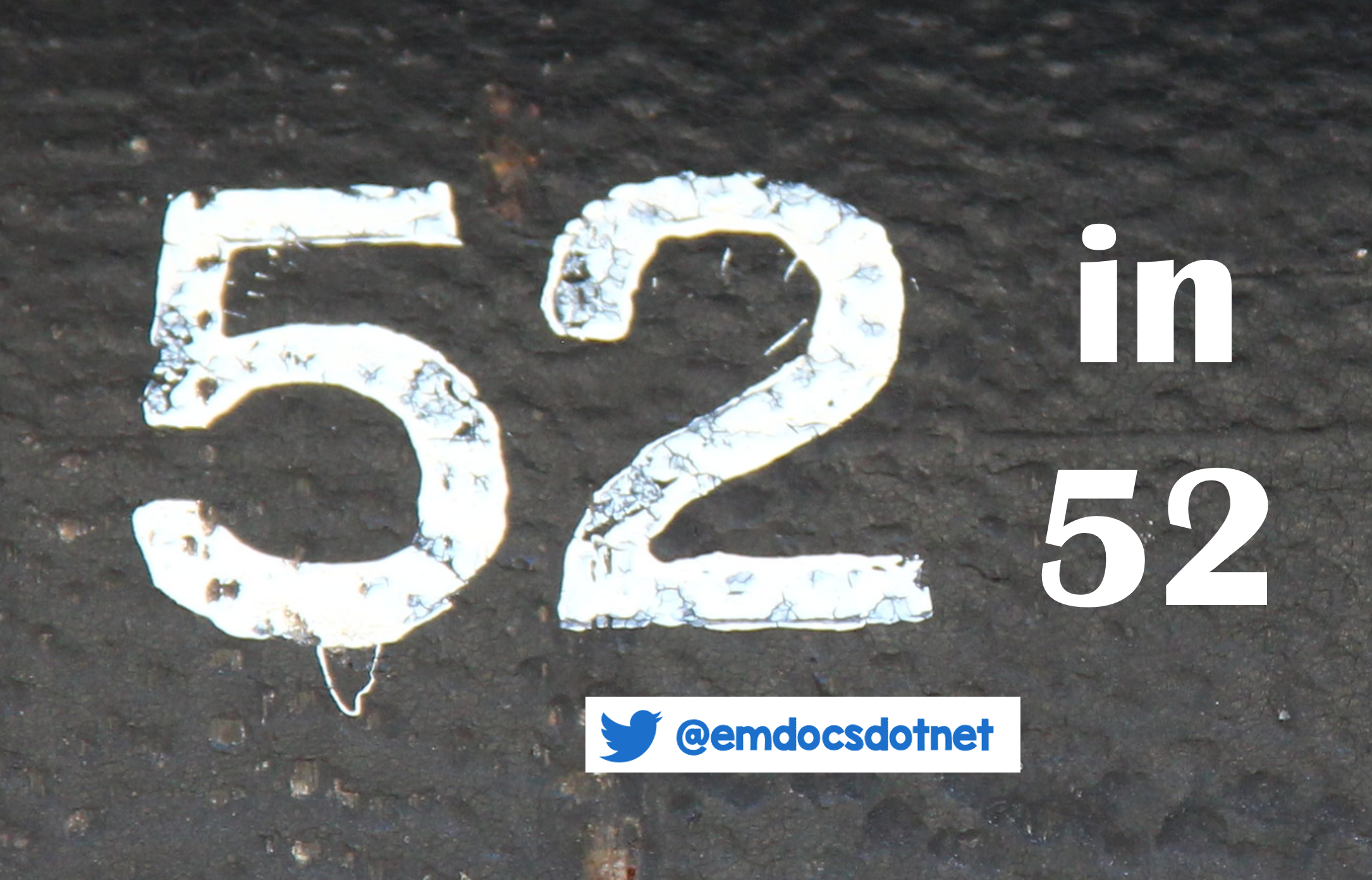Welcome back to the “52 in 52” series. This collection of posts features recently published must-know articles. Post #24 looks at angiography after out-of-hospital cardiac arrest without ST elevation.

Author: Brannon Inman (Chief Resident, Emergency Medicine Physician, San Antonio, TX) // Reviewed by: Alex Koyfman, MD (@EMHighAK); and Brit Long, MD (@long_brit)
Angiography after Out-of-Hospital Cardiac Arrest without ST-Segment Elevation
AKA: The “TOMAHAWK” Trial
Question:
In patients with Out-of-Hospital Cardiac Arrest (OHCA) and no STEMI on EKG, does routine immediate angiography improve 30-day all-cause mortality?
Study design: multicenter, open-label, randomized controlled trial
PICO
Population:
- Enrolled
- Adults ≥ 30 years old
- All comers with Out-of-Hospital Cardiac Arrest (OHCA)
- Included those with PEA/ Asystole
- Included those with VT/VF
- ROSC achieved
- Exclusion Criteria
- ST-segment elevation or LBBB
- No return of circulation on hospital admission
- Severe hemodynamic or electrical instability that required immediate angiography or intervention
- Life-threatening arrhythmia
- Cardiogenic shock
- Obvious extra-cardiac cause
- TBI
- Metabolic/electrolyte disorder
- Toxicologic cause
- Primary respiratory failure
- Suffocation/ drowning
- In-hospital cardiac arrest
- Pregnancy (known or suspected)
- Participation in another trial interfering with the research questions of TOMAHAWK trail

Intervention:
- Immediate transfer to angiography lab
Comparator:
- Delayed or selective angiography
- Patients admitted to ICU
- angiography delayed a minimum of 24 hours
- Criteria for angiography earlier than 24 hours:
- Substantial myocardial damage
- Troponin ≥ 70 times upper limit of normal ≥ 6 hours post-arrest
- CK ≥ 10 times upper limit of normal ≥ 6 hours post-arrest
- Electrical instability
- Cardiogenic shock
- Development of new STEMI
- Substantial myocardial damage
Outcome:
- Primary outcome was 30-day all-cause mortality
- No significant difference (Immediate vs Delayed)
- 54 vs 46 %
- HR 1.28 (95% CI, 1.00 – 1.63)
- No significant difference (Immediate vs Delayed)
- No statistically significant difference in secondary outcomes
- Myocardial Infarction: 0% vs 0.8%
- Severe Neurological Deficit: 18.8% vs 12.7%
- Median ICU LOS: 7 vs 8 days
- 30d rehospitalization for congestive cardiac failure: 0.4% vs 0.4%
- Median peak cardiac enzymes:
- Trop T: 0.39 vs 0.34 μg/L
- Trop I: 1.46 vs 1.10 μg/L
- Median peak creatinine: 133 μmol/L vs 133 μmol/L
- Moderate / Severe bleeding: 4.6% vs. 3.4%
- Stroke: 1.6% vs. 2.1%
- AKI leading to RRT: 18.9% vs. 15.8%
- Explicitly stated the secondary outcomes not adjusted for multiplicity and may not be reproducible (meaning they are hypothesis-generating only)
- Coronary Angiography
- Angiography performed: 95.5% vs 62.2%
- Median time from arrest until angiography: 2.9 vs 46.9 hrs
- Culprit Lesion: 38.1 vs 43.0%
- PCI performed: 37.2% vs 43.2%
Take Aways:
- Negative Trial
- There does not appear to be a significant benefit in immediate angiography vs delayed. However, angiography was delayed quite a bit (2.9 vs 46.9 hours).
- Interestingly there appears to be a trend toward mortality in the immediate angiography group, though this was not statistically significant.
- Overall, the groups were well balanced. There was a slightly higher shockable rhythm rate in the delayed group. Troponin I was slightly higher in the immediate group, and there was history of CABG was more frequent in the delayed group.
- This was a sick cohort of patients, with an average GCS of 3 in both groups, average lactate of 5 mmol/L in the immediate group, and 4.9 mmol/L in the delayed.
- There was a high rate of cross-over from the delayed group (46, 17% had angiography in less than 24 hrs).
- 22 were study violations
- 24 due to prespecified criteria for early angiography
- About 4.5% of patients in the immediate group did not have angiography, and only 62.2 % of the delayed group had angiography.
- The delayed group had a higher percentage of PCI and culprit lesions. I have to wonder if this is because operators were allowed to be selective about which patients went to angiography in this group.
My Take:
- Based on these data, immediate angiography in otherwise stable OHCA patients who do not have STEMI or LBBB on their post-ROSC EKG does not improve .
References:
- Desch S, Freund A, Akin I, et al. Angiography after Out-of-Hospital Cardiac Arrest without ST-Segment Elevation. N Engl J Med. 2021;385(27):2544-2553. doi:10.1056/NEJMoa2101909.










